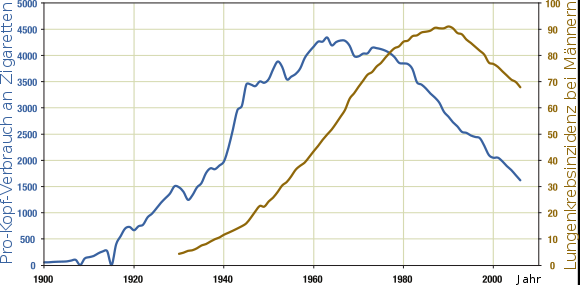Lung Cancer
Lung cancer, or lung carcinoma, is a malignant tumour originating in the lung tissue, often triggered by genetic damage to airway cells.
Tobacco smoking is the primary cause, but asbestos, radon, and other environmental mutagens also contribute. Early detection is difficult as initial symptoms are often absent or nonspecific.
Signs and Symptoms
Early lung cancer typically presents no symptoms. When symptoms arise, they are usually respiratory, including coughing, shortness of breath, and chest pain. Coughing may bring up blood, while shortness of breath and persistent chest pain are common. Systemic symptoms like loss of appetite, weight loss, and fever can also occur.
Specific tumour locations can cause additional symptoms, such as difficulty swallowing, hoarseness, and Horner's syndrome. Around one-third of patients experience symptoms from metastases, including headaches, bone pain, and liver enlargement. Paraneoplastic syndromes, due to hormone release, can cause hypercalcaemia, hypokalaemia, and hyponatraemia, among other complications.
Diagnosis

Imaging tests like chest X-rays and CT scans are initial steps in diagnosing suspected lung cancer. A definitive diagnosis requires a biopsy, often obtained via bronchoscopy or fine needle aspiration.
Histological examination by a pathologist confirms cancer and classifies it into small-cell lung cancer (SCLC) or non-small-cell lung cancer (NSCLC). NSCLC is further divided into adenocarcinoma, squamous-cell carcinoma, and large-cell carcinoma.
Staging assesses the cancer's spread and informs treatment. SCLC is staged as limited or extensive, while NSCLC uses the TNM system (Tumour, Node, Metastasis) to classify stages I-IV.
Treatment
Treatment varies based on cancer type, stage, and patient health. Early-stage NSCLC is often treated surgically, removing the tumour and possibly combining this with chemotherapy and radiotherapy. Advanced stages might use targeted molecular therapies and immune checkpoint inhibitors.
For SCLC, chemotherapy combined with radiotherapy is standard, though relapse is common. Limited-stage SCLC may benefit from prophylactic cranial irradiation to prevent brain metastases.


Palliative care aims to improve quality of life by managing symptoms like pain and shortness of breath. Techniques include supplemental oxygen, stenting of obstructed airways, and pain management using the WHO three-tiered system. End-of-life care focuses on comfort, managing pain and respiratory distress, and addressing terminal secretions.

Prognosis
Prognosis depends on cancer type, stage at diagnosis, and patient demographics. Five-year survival rates are around 19%, higher for early-stage diagnoses. SCLC has a poorer prognosis, with a five-year survival of 10-15%. Younger patients and those who quit smoking have better outcomes.
Lung cancer is the most diagnosed cancer globally, with 2.2 million cases in 2020. Incidence and survival rates vary widely, influenced by smoking prevalence and healthcare quality.

Causes
Lung cancer primarily results from genetic mutations induced by tobacco smoke. Other significant causes include environmental exposures to asbestos, radon, and various industrial chemicals. Chronic inflammatory diseases of the lungs and genetic predispositions also contribute.

Prevention
Reducing lung cancer risk focuses on smoking cessation, bolstered by public health policies such as increased tobacco taxes, smoking bans, and public education. Dietary factors, body weight, and physical activity also influence risk. High consumption of fruits and vegetables and maintaining a healthy weight are associated with lower lung cancer risk.


Epidemiology
Lung cancer is the most diagnosed and deadliest cancer worldwide, with significant geographic and gender variations. Tobacco smoking is the main risk factor, with secondhand smoke also contributing substantially. The incidence of lung cancer among non-smokers is stable or increasing even as overall rates decline due to reduced smoking prevalence.
Self-assessment MCQs (single best answer)
What is the primary cause of lung cancer?
Which of the following is a systemic symptom of lung cancer?
What is the main diagnostic method to confirm lung cancer?
Which type of lung cancer is more likely to be treated with chemotherapy and radiotherapy rather than surgery?
What is the five-year survival rate for early-stage lung cancer diagnosis?
Which of the following is a common symptom of metastases in lung cancer patients?
What staging system is used for non-small-cell lung cancer (NSCLC)?
Which of the following is a preventive measure for reducing lung cancer risk?
Paraneoplastic syndromes in lung cancer patients can cause all of the following EXCEPT:
Which treatment aims to improve the quality of life by managing symptoms in lung cancer patients?
Dentaljuce
Dentaljuce provides Enhanced Continuing Professional Development (CPD) with GDC-approved Certificates for dental professionals worldwide.
Founded in 2009 by the award-winning Masters team from the School of Dentistry at the University of Birmingham, Dentaljuce has established itself as the leading platform for online CPD.
With over 100 high-quality online courses available for a single annual membership fee, Dentaljuce offers comprehensive e-learning designed for busy dental professionals.
The courses cover a complete range of topics, from clinical skills to patient communication, and are suitable for dentists, nurses, hygienists, therapists, students, and practice managers.
Dentaljuce features Dr. Aiden, a dentally trained AI-powered personal tutor available 24/7 to assist with queries and provide guidance through complex topics, enhancing the learning experience.
Check out our range of courses, or sign up now!


